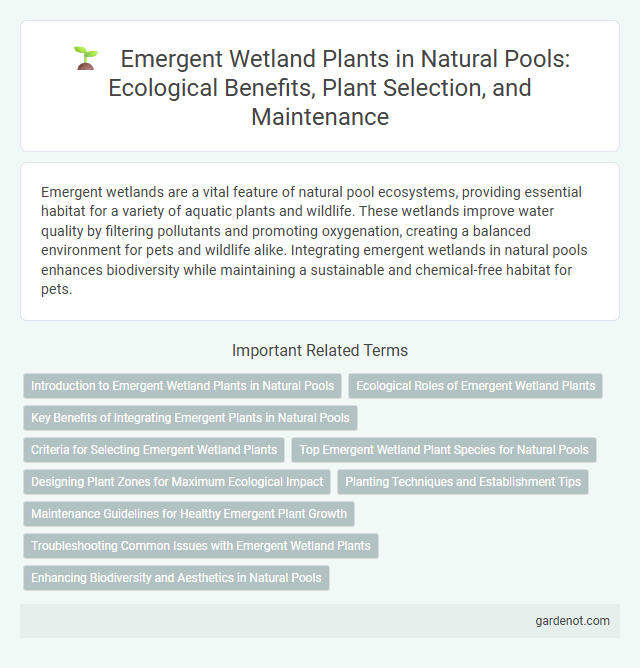Emergent wetlands are a vital feature of natural pool ecosystems, providing essential habitat for a variety of aquatic plants and wildlife. These wetlands improve water quality by filtering pollutants and promoting oxygenation, creating a balanced environment for pets and wildlife alike. Integrating emergent wetlands in natural pools enhances biodiversity while maintaining a sustainable and chemical-free habitat for pets.
Introduction to Emergent Wetland Plants in Natural Pools
Emergent wetland plants in natural pools play a vital role in water filtration, habitat creation, and nutrient cycling by growing at the water's edge with roots submerged and stems above the surface. Species such as cattails, bulrushes, and sedges enhance biodiversity while stabilizing soil and reducing erosion in natural pool ecosystems. These plants contribute to maintaining water clarity and ecological balance through their ability to absorb pollutants and provide shelter for aquatic and terrestrial wildlife.
Ecological Roles of Emergent Wetland Plants
Emergent wetland plants play a crucial role in natural pools by stabilizing sediments and reducing erosion through their extensive root systems. These plants enhance water quality by filtering pollutants and absorbing excess nutrients, which helps prevent algal blooms. Furthermore, emergent vegetation provides critical habitat and breeding grounds for diverse aquatic and terrestrial wildlife species.
Key Benefits of Integrating Emergent Plants in Natural Pools
Emergent plants in natural pools play a crucial role in water purification by absorbing excess nutrients and filtering pollutants, which enhances overall water quality. Their root systems provide essential habitat for beneficial microorganisms that support natural biological filtration and biodiversity. These plants also contribute to natural oxygenation and stabilize pool edges, reducing erosion and maintaining ecological balance in the aquatic environment.
Criteria for Selecting Emergent Wetland Plants
Emergent wetland plants must exhibit strong root systems to stabilize soil and prevent erosion in natural pools while tolerating fluctuating water levels and varying oxygen availability. Optimal species demonstrate high tolerance to nutrient variability, efficiently filtering pollutants and enhancing water quality through natural biofiltration. Selecting native plants that provide habitat for local wildlife and support biodiversity ensures ecological balance and long-term sustainability of emergent wetlands in pool ecosystems.
Top Emergent Wetland Plant Species for Natural Pools
Top emergent wetland plant species for natural pools include cattails (Typha latifolia), bulrushes (Schoenoplectus spp.), and arrowhead (Sagittaria latifolia), known for their robust root systems that enhance water filtration and provide habitat for aquatic wildlife. These plants play a crucial role in maintaining water clarity by absorbing excess nutrients and stabilizing sediment, which supports the ecological balance of the pool. Incorporating diverse emergent species ensures effective biofiltration and contributes to the aesthetic and environmental value of natural swimming pools.
Designing Plant Zones for Maximum Ecological Impact
Designing plant zones in emergent wetlands enhances biodiversity and water purification by strategically arranging native species like cattails, bulrushes, and sedges to optimize nutrient uptake and habitat creation. Zoning plants according to depth and sunlight exposure promotes natural filtration processes while supporting amphibian and bird populations critical for ecosystem balance. Effective emergent wetland design integrates hydrological dynamics and seasonal growth patterns to maximize ecological functions in natural pool environments.
Planting Techniques and Establishment Tips
Emergent wetland plants thrive in the shallow edges of natural pools, providing essential filtration and habitat functions. Planting techniques include grouping species with varying root depths and using biodegradable pots to stabilize young plants during establishment. Ensuring gradual water level fluctuations and maintaining a nutrient balance supports rapid root development and long-term plant health.
Maintenance Guidelines for Healthy Emergent Plant Growth
Emergent wetlands in natural pools require consistent maintenance to support healthy plant growth, including regular removal of invasive species and debris to prevent nutrient overload and water stagnation. Monitoring water levels and pH balance helps maintain ideal conditions for emergent plants like cattails and sedges, which play a key role in nutrient filtration and habitat creation. Seasonal pruning and replanting enhance the wetland's resilience, promoting biodiversity and water quality improvement.
Troubleshooting Common Issues with Emergent Wetland Plants
Emergent wetland plants in natural pools often face challenges such as nutrient imbalances, causing yellowing leaves and stunted growth. Root rot frequently occurs due to poor water circulation or overly saturated substrates, necessitating improved drainage and aeration techniques. Effective troubleshooting involves regular monitoring of water quality parameters and adjusting planting density to promote healthy plant development.
Enhancing Biodiversity and Aesthetics in Natural Pools
Emergent wetlands in natural pools provide critical habitat for diverse aquatic and terrestrial species, significantly enhancing biodiversity by supporting frogs, dragonflies, and native plants. These plants act as natural biofilters, improving water quality while adding visual appeal through lush greenery and seasonal blooms. Integrating emergent vegetation zones creates a balanced ecosystem that promotes self-sustaining water clarity and vibrant wildlife activity.
Emergent wetland Infographic

 gardenot.com
gardenot.com